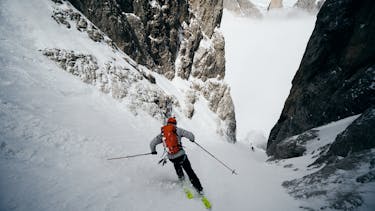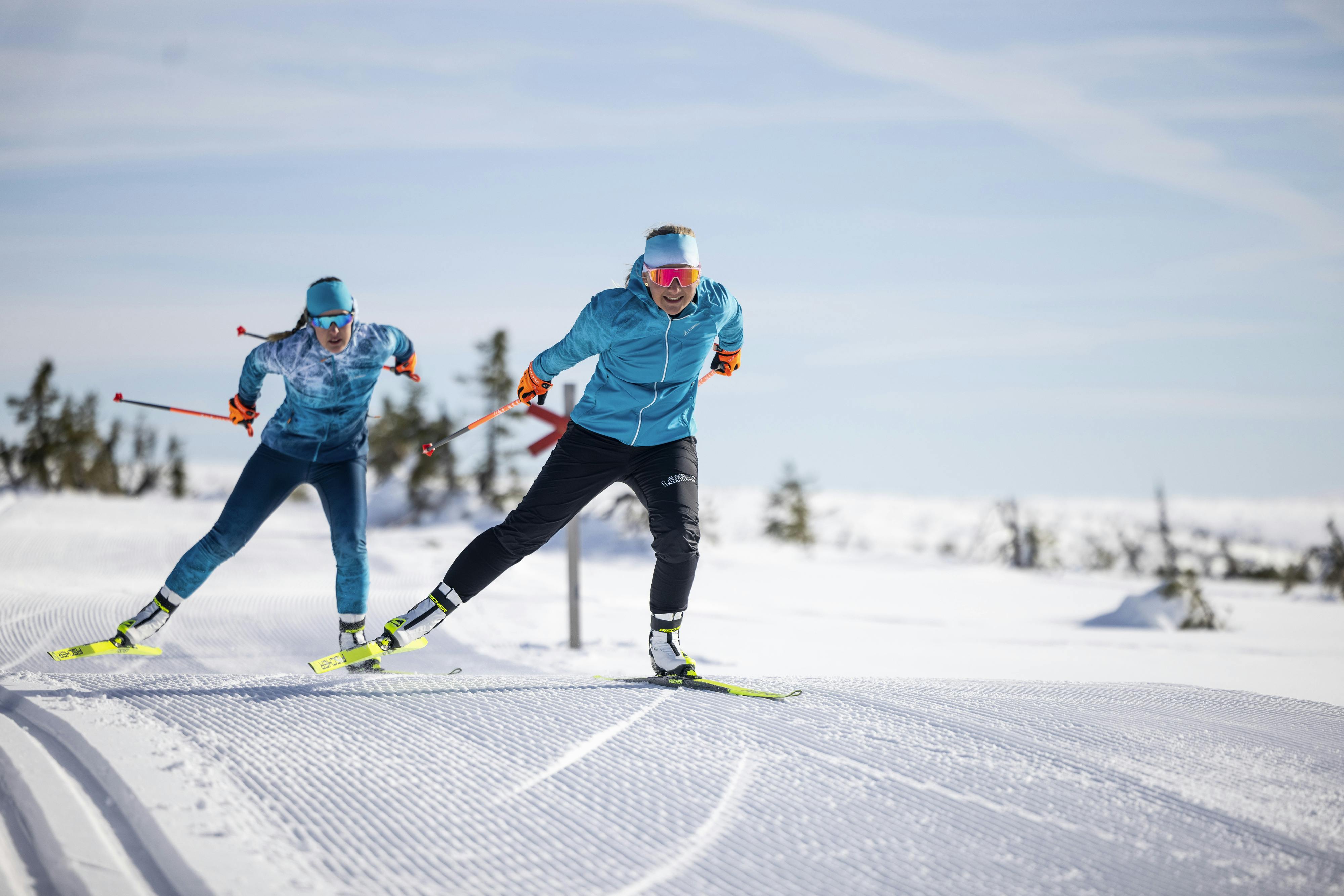Recognizing avalanche risk
It’s almost impossible to anticipate an avalanche or assess the danger of an imminent one simply by eye or relying on anything other than a local expert. You can’t out ski or outrun an avalanche. You can’t “swim” your way to safety. Never assume you’re entirely safe.
Avalanche Risk Scale
There is a uniform European Avalanche Risk Scale. North America has a similar one. The standards, and local risk assessment, are the same for all European (and, separately, North American) skiing areas.
When referencing the scale, it’s important to realize the risk does not increase in a linear manner from level to level. The risk is doubled at each level.
Level 1 is the safest level, and there are essentially no limits on where skiing, boarding, etc. are safe. But at Level 3 the risk has already increased substantially, to a “considerable” risk of avalanche. At Level 5 no activity would be permitted in exposed recreation areas, and no independent backcountry activity should take place. Note there is no zero level, since there is literally always some risk of an avalanche.
Regardless of numbers on a scale, warning signs, etc., common sense is the first defense against avalanche danger. Obvious overhangs, high drifts, and huge amounts of new snow are all warning signs that have to be heeded. Think defensively, and be prepared to give up the day’s plan, or change a route where needed.
For general reference only. Please go to the source below for full details.
European Avalanche Danger Scale
| Danger level | Snowpack stability | Likelihood of triggering | |
|---|---|---|---|
| 1 | low | The snowpack is well bonded and stable in general. | Triggering is generally possible only from high additional loads in isolated areas of very steep, extreme terrain. Only small and medium natural avalanches are possible. |
| 2 | moderate | The snowpack is only moderately well bonded on some steep slopes; otherwise well bonded in general. | Triggering is possible, primarily from high additional loads, particularly on the indicated steep slopes. Very large natural avalanches are unlikely. |
| 3 | considerable | The snowpack is moderately to poorly bonded on many steep slopes. | Triggering is possible, even from low additional loads, particularly on the indicated steep slopes. In certain situations some large, and in isolated cases very large natural avalanches are possible. |
| 4 | high | The snowpack is poorly bonded on most steep slopes. | Triggering is likely, even from low additional loads, on many steep slopes. In some cases, numerous large and often very large natural avalanches can be expected. |
| 5 | very high | The snowpack is poorly bonded and largely unstable in general. | Numerous very large and often extremely large natural avalanches can be expected, even in moderately steep terrain. |
Source: https://lawine.tirol.gv.at/data/eaws/2018-19%20European%20Avalanche%20Danger%20Scale_de.pdf
Note the mention of “low” and “high” additional loads. A high additional load might be a large group of people in a concentrated area, or it may also be skiers or snowboarders taking jumps or their high impact landings. A low load, by contrast, is a small group of people, or those not in a large group, and normal skiing and boarding
Avalanche causes
Wind is the number one cause of avalanche conditions, as it carves out and piles up huge masses of snow in unstable formations. It destroys the actual structure of snow crystals, allowing it to be packed densely to form a massive slab of snow.
Other weather conditions are lesser, but still notable contributors, especially:
New snow
- Rain
- Temperature swings
All four weather elements constantly change the composition of accumulated snow. It’s critical to keep this in mind, especially skiing or touring in the backcountry.
The type of slope
Steeper slopes logically increase the risk of an avalanche, with a 30° slant marking a significant danger threshold. Lesser traversed slopes are also a greater danger. Ravines, narrow rock channels, and similar topography are especially dangerous since they are susceptible to avalanches where deep snow would accumulate over victims.
Snow composition
When a layer of new snow piles up on a base of older, more compacted snow, it is quite possible the two layers never really bind together, even over time. This instability and separation of layers is a typical cause of an avalanche. The top layer is simply too heavy, or is disturbed by outside forces, and slides off the lower layer.
The same effect can develop as water seeps into the snow and creates a separation in two masses of snow or damages the integrity of a large mass.
Types of avalanche
In general terms, there are four types of avalanche.
- Slab avalanche: Marked by a long crack perpendicular to the slope. That crack is the rear of a large and heavy slab of snow that breaks away en masse and thunders downhill. It is hard to recognize from below and therefore especially dangerous for skiers and others. These can break loose on slopes as shallow as 25°.
- Glide avalanche: Similar in origin to a slab avalanche, but here the surface of a snowfield comes loose and slides downward, typically on steeper slopes. Unlike slab avalanches, which can be caused by human activity, these are usually the result of water or gravity.
- Powder avalanche: These will sometimes start as a slab avalanche but are differentiated by the huge quantity of fast rushing loose snow that accumulates. These reach speeds of up to 300kmh (186mph) and are especially destructive.
- Wet avalanche: Typically occurring in spring in rain or during a steep rise in temperature, rather than through human activity. Running water works its way through the snowpack and weakens its integrity and adhesion, causing it to break loose.
Avalanche risk on the slopes
Experienced experts at ski resorts understand the likelihood and dangers of avalanches, so their warnings are to be taken absolutely seriously.
When possible, potential avalanche areas are handled with controlled explosions to dislodge as much at-risk snow as possible. This is not necessarily the case with off-piste areas, which is another reason they are far riskier than the official ski areas.

Plan safely
Even in a resort setting, take the time to research the avalanche risk level and plan your day accordingly. Certainly do this before any backcountry activity.
Avalanche risk has a direct correlation to the steepness of the area. At danger level 2, choose an area with a slope no steeper than 40°. At danger level 3, you’ll be significantly safer on a slope no steeper than 35°. At danger level 4, that safety increase comes when the slope is less than 30°.
Be aware of the best sources. For example, lawine.at or lawinen.at, and the Whatsapp notifications from “Lawinenwarndienst Tirol” are the best sources in a key Austrian ski area. Every major winter sport area will have something similar, along with a source you can simply call.
Winter sports areas always have detailed weather reports available. Be wary of drastic temperature swings, a lot of new snow, and high winds. Play it safe, because avalanches rarely give any warning.

Avalanche gear
Longtime winter sport participants have inevitably heard, seen, or seen the aftereffects of an avalanche. They understand that an investment in proper emergency equipment is a wise one.
The basic setup consists of:
- Avalanche beacon (transceiver)
- Rescue shovel
- Avalanche probe
Additional considerations:
- A quick-inflating avalanche airbag pack is a more advanced safety item, but is readily available at any outdoor specialist.
- Preprogram an emergency number into your cell phone.
- Backcountry travelers consider a first-aid kit and bivouac sack as standard items.
Don’t wait till an emergency- take the time to familiarize yourself with the use of all these items before you head out. Public and private Alpine clubs offer excellent emergency training courses, which we highly recommend.
The absolute essentials they will teach you are that as an avalanche approaches you should activate your airbag and remove your poles form your wrists.
Safety rules
Be sure everyone in your group is aware of the following guidelines for winter sport safety.
- Take warnings seriously. Respect the experts who are offering specific avalanche and weather warnings. It is your responsibility to be informed and prepared.
- Recognize potential traps in the topography. Narrow, walled-in areas, hollows, and overhanging rock outcroppings or cornices are to be avoided whenever possible. Large, long cracks in the snow indicate avalanche conditions may have formed anywhere on the mountain.
- Remember that large dumps of new snow, or large drifts, may be sitting atop a layer of hard snow and be unstable. Masses of snow that have been carved by strong winds are definitely dangerous.
- If you’re within sight or hearing range of other avalanches- of any size- realize that could just as easily occur where you are. The same is true for signs of a recent avalanche- it may not be the last one.
- Maintain 10-20 meters (similarly in yards) between you and the person ahead of you on an ascent. Add even more of a gap on the descent. Agree on meeting points along the way rather than staying closely bunched the entire time.



